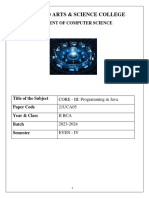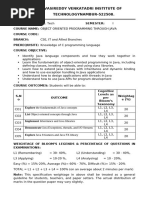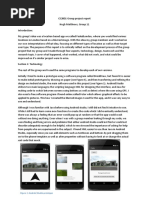0 ratings0% found this document useful (0 votes)
16 viewsModule Summary
The document provides an overview of object-oriented programming concepts including objects, classes, inheritance, polymorphism, abstraction, encapsulation and modularity. It also covers topics like UML modeling, exceptions, file input/output and preparing for an exam on these object-oriented concepts in Java.
Uploaded by
sheen gayCopyright
© © All Rights Reserved
We take content rights seriously. If you suspect this is your content, claim it here.
Available Formats
Download as DOCX, PDF, TXT or read online on Scribd
0 ratings0% found this document useful (0 votes)
16 viewsModule Summary
The document provides an overview of object-oriented programming concepts including objects, classes, inheritance, polymorphism, abstraction, encapsulation and modularity. It also covers topics like UML modeling, exceptions, file input/output and preparing for an exam on these object-oriented concepts in Java.
Uploaded by
sheen gayCopyright
© © All Rights Reserved
We take content rights seriously. If you suspect this is your content, claim it here.
Available Formats
Download as DOCX, PDF, TXT or read online on Scribd
You are on page 1/ 3
Module Summary
- Introduction to object technology
- Principles of visual modelling: aims of modelling, importance of modelling and model driven
architecture (MDA)
- Concepts of object orientation I: object and class (states and operations), relationship
between objects and classes, package for organising design elements
o Java class
o Constructor methods
o Instance variables/ methods
o super vs this keyword in Java
o static vs non-static members
- Concepts of object orientation II:
o Abstraction – to distinguish characteristics among entities
o Encapsulation – to wrap object data and operations together as a single unit
Private/ protected visibility
o Modularity – to break-up complex problem into manageable unit
o Hierarchy – to identify the general objects and specialised objects
Generalisation – single inheritance and multiple inheritance
- UML Use case modelling
o Use case diagramming
o UML notations for the use case diagram
- UML Class diagram
o Class diagramming
o UML notations for the class diagram
o Class relationships: association, aggregation/ composition, inheritance, realisation,
dependency and etc
o Transform UML class diagram into Java code
- Inheritance and Polymorphism with code samples
o Single inheritance
o Multiple inheritance
o Multi-level inheritance
o Inheriting methods and overriding methods
- Abstraction and Polymorphism
o Abstract classes and methods
o Concrete class
o Interface in Java
o Interfaces vs abstract classes
- Graphical User Interface (GUI)
o AWI & Swing package
o Swing components
o Window (JFrame) or container and input components
o Handling events
- Exception handling
o Exception class hierarchy
o Exception handler
o Handling exception with trycatch, trycatch-finally
o throws vs throw keyword in Java
o custom exception class
- File Input/ Output (IO)
o File types: text file and binary file
o Text IO - Reader/ Writer
o Binary IO – InputStream/ OutputStream
o IO Exception classes
o Handling IO exception
Exam information
- Section A: 20 MCQs (20 marks)
- Section B: 2 questions (25 marks)
Preparation to be able to:
- Coding in Java (object oriented programming)
- Coding in Java basic covering variable declaration and initialization, control structures,
expression evaluation, logical/arithmetic/(in/de)crement operators, ternary operator (?:),
java keywords (extends, this, super, static, private, protected, public), array and etc
- Trace output
You might also like
- Thi Cuối Kỳ 2 (2020-2021) Pttk Hướng Đối Tượng: Bài làm của sinh viênNo ratings yetThi Cuối Kỳ 2 (2020-2021) Pttk Hướng Đối Tượng: Bài làm của sinh viên17 pages
- 24CSE102_Object Oriented Programming_ 1st Sem_CPSNo ratings yet24CSE102_Object Oriented Programming_ 1st Sem_CPS3 pages
- Object-Oriented Programming Through JavaNo ratings yetObject-Oriented Programming Through Java12 pages
- R22B.Tech - CSE (DATASCIENCE) CourseStructureSyllabus2 (1) - 46-47No ratings yetR22B.Tech - CSE (DATASCIENCE) CourseStructureSyllabus2 (1) - 46-472 pages
- Object Oriented Programming Through JavaNo ratings yetObject Oriented Programming Through Java131 pages
- Java Programming (20A05505A) : Iii - B.Techi-SemesterNo ratings yetJava Programming (20A05505A) : Iii - B.Techi-Semester553 pages
- Object_Oriented_Programming_through_Java_Digital_Notes_Maruthi_PNo ratings yetObject_Oriented_Programming_through_Java_Digital_Notes_Maruthi_P136 pages
- OOPJ_R23_II-I_MicroSylllabusFinalModelPaperNo ratings yetOOPJ_R23_II-I_MicroSylllabusFinalModelPaper8 pages
- Syllabus-OBJECT ORIENTED PROGRAMMING THROUGH JAVANo ratings yetSyllabus-OBJECT ORIENTED PROGRAMMING THROUGH JAVA2 pages
- Object Oriented Programming Through JavaNo ratings yetObject Oriented Programming Through Java130 pages
- CORE JAVA Syllabus: 1. Core Java Programming Introduction of JavaNo ratings yetCORE JAVA Syllabus: 1. Core Java Programming Introduction of Java9 pages
- Lecture 1 Introduction To Object Oriented Programming ApproachNo ratings yetLecture 1 Introduction To Object Oriented Programming Approach29 pages
- Java Algorithms for Beginners: A Practical Guide with ExamplesFrom EverandJava Algorithms for Beginners: A Practical Guide with ExamplesNo ratings yet
- Mastering Advanced Object-Oriented Programming in Java: Unlock the Secrets of Expert-Level SkillsFrom EverandMastering Advanced Object-Oriented Programming in Java: Unlock the Secrets of Expert-Level SkillsNo ratings yet
- Software Development Laboratory Hospital ManagementNo ratings yetSoftware Development Laboratory Hospital Management88 pages
- Normalization of Duplicate Recordsfrom Multiple Sources: Bachelor of Technology IN Computer Science and EngineeringNo ratings yetNormalization of Duplicate Recordsfrom Multiple Sources: Bachelor of Technology IN Computer Science and Engineering60 pages
- OOAD - Ch.01 - Why Do We Model Things 2No ratings yetOOAD - Ch.01 - Why Do We Model Things 234 pages
- Preliminary Investigation: 1 School Management SystemNo ratings yetPreliminary Investigation: 1 School Management System69 pages
- Software Requirements Engineering UML LectureNo ratings yetSoftware Requirements Engineering UML Lecture33 pages
- Assignment Class, Object and Use Case Diagrams: Task 01: Aggregation Vs Composition (10 Scores)No ratings yetAssignment Class, Object and Use Case Diagrams: Task 01: Aggregation Vs Composition (10 Scores)4 pages
- UML Class Diagrams: Applying UML and Patterns Craig LarmanNo ratings yetUML Class Diagrams: Applying UML and Patterns Craig Larman48 pages

























































































